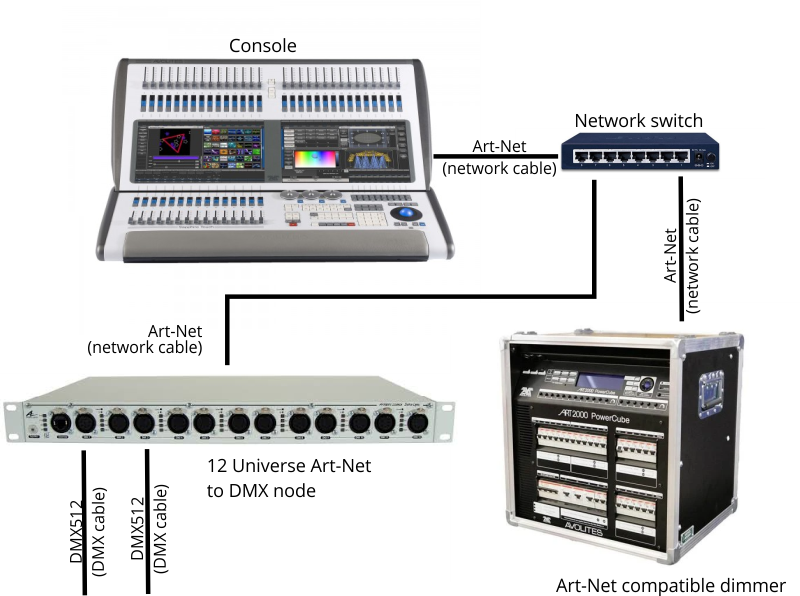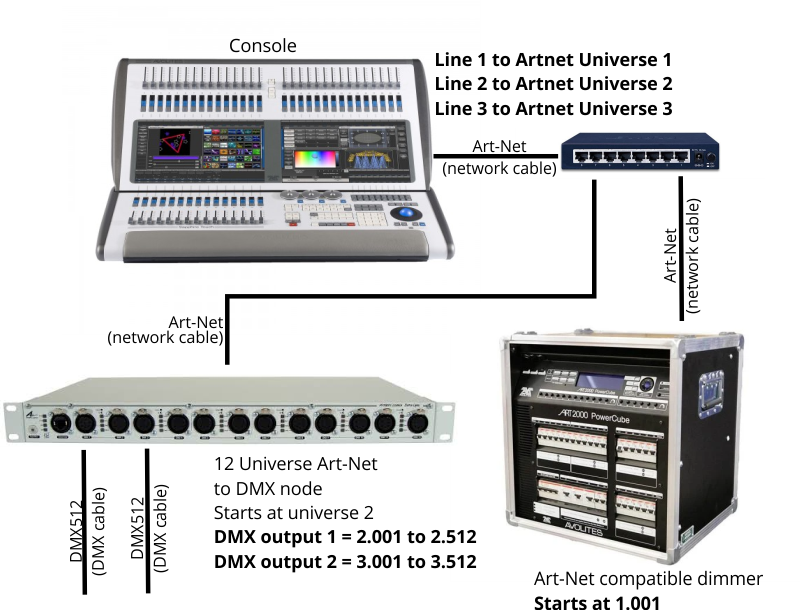Steuern von Geräten über Netzwerk
Bevor das Pult mit anderen Geräten über ein Netzwerk kommunizieren kann, muss es eine eindeutige Netzwerkadresse bekommen; diese wird 'IP-Adresse' genannt.
Einstellen der IP-Adresse des Pultes
Es wird empfohlen, die integrierte Adressvergabe des Pultes zu verwenden. Alternativ kann aber auch manuell eine Adresse vergeben werden. Siehe Einstellen der IP-Adresse mit Details zur IP-Adressierung.
- Öffnen Sie das System-Menü (mittels Avo + Disk) und drücken Sie Network Settings.
- Drücken Sie Local Area Connection. Manche Pult verfügen über mehrere Netzwerkanschlüsse - wählen Sie also hier den betreffenden aus.
- Überprüfen Sie, dass Subnet Mask auf
255.255.255.0steht. - Drücken Sie Set IP
2.*.*.*. - Betätigen Sie Save settings.
- Verlassen Sie das System-Menü mit Exit.
Einige Geräte haben möglicherweise feste IP-Adressen aus dem Bereich
2.*.*.*oder10.*.*.*- in diesem Fall muss auch die Adresse des Pultes in diesem Bereich liegen.Benötigen Sie eine Adresse aus einem anderen Adressbereich, so drücken Sie auf IP Address = ... und geben die Adresse mit den Zifferntasten ein.
Einrichten der DMX-Ausgänge
Das Pult arbeitet intern mit max. 64 DMX-Universen (16 direkt im Pult, bis zu 64 mit TitanNet), die einzeln auf die DMX-Buchsen sowie über Netzwerk-Knoten geroutet werden können. Der T1 ist auf ein, der T2 auf zwei Universen beschränkt. Die einzelnen Linien können sowohl über die DMX-Anschlüsse als auch über Netzwerk ausgegeben werden.
Die Zuordnung interner DMX-Linien zu Netzwerklinien erfolgt im Menü DMX Settings. Oft wird man einfach Linie 1 auf Netzwerk-Universum 1, Linie 2 auf Universum 2 etc. zuweisen, aber mitunter - etwa auf Tour zur Anpassung an das vorhandene Netzwerk - sieht das auch ganz anders aus.
Beispiel für ein einfaches Art-Net-System
Es gibt hauptsächlich zwei Systeme zur Übertragung von Licht-Steuersignalen über Netzwerk: Art-Net und sACN. Titan unterstützt beide Protokolle. In diesem Abschnitt wird die Einrichtung eines Art-Net-Systems erläutert.
Art-Net ist kein gerätespezifisches Protokoll, sondern wird von einer wachsenden Anzahl von Herstellern anerkannt und in immer mehr Produkte integriert. Viele Geräte (etwa Dimmer oder Bewegungsscheinwerfer) können direkt per Art-Net verbunden werden, so dass kein separater Konverter erforderlich ist. Benötigt man hingegen 'normales' DMX, so kann dies über spezielle Art-Net-DMX-Konverter (oft als Node bezeichnet) realisiert werden.
Im nachstehenden Schema ist exemplarisch ein Art-Net-fähiges Pult (wie etwa ein Titan-Pult) über einen Netzwerk-Switch mit einem Art-Net-fähigen Dimmer und einem Konverter verbunden.

Sobald das System entsprechend verkabelt ist, müssen die Geräte (Knoten, Nodes) konfiguriert werden.
Am Dimmer stellen Sie die Startadresse 1.001 ein (Universum 1, Adresse 1).
Den Konverter/Node stellen Sie so ein, dass er ab Universum 2 arbeitet; handelt es sich z.B. um einen Konverter mit 12 Universen, so wandelt er die Universen 2 bis 13 von Art-Net zu DMX.
Im Menü DMX Settings ordnen Sie die internen Linien den verschiedenen Art-Net-Universen (1-256) zu. Dabei kann jede interne Linie auf mehrere Art-Net-Universen sowie auch parallel auf die DMX-Ausgänge des Pultes geroutet werden.
Ist alles ordnungsgemäß eingerichtet, sollten der Dimmer und der Node als verfügbare Ausgabegeräte auf der linken Seite des DMX-Settings-Fensters auftauchen. Dabei zeigen Sie auch an, welches Universum sie verarbeiten.
Im Beispiel erfolgt die Zuordnung daher wie folgt:
Klicken Sie links auf das erste Universum des Dimmers, und danach rechts auf Linie 1.
Klicken Sie links auf das erste Universum des Nodes, und danach rechts auf Linie 2.
Klicken Sie links auf das zweite Universum des Nodes, und danach rechts auf Linie 3.

Beim Patchen in Titan geben Sie nun dem Dimmer die Adresse 1.001 - 1.024. Geräten auf der ersten Linie des Nodes geben Sie die Adresse 2.001 - 2.512, Geräten auf der zweiten Linie des Nodes geben Sie die Adresse 3.001 - 3.512.
- Für weitere Art-Net-Einstellungen klicken Sie auf das kleine beim Art-Net-Modul. Im Abschnitt Art-Net-Einstellungen werden diese genauer erklärt.
Als mögliche Art-Net-Geräte werden ggf. auch "Unpolled" oder "Unknown" angezeigt:
Unpolled, bzw. 'nicht abgefragt', sind zusätzliche Linien für Geräte mit mehr als 4 Linien: die Art-Net-Spezifikation sieht nur 4 Linien vor, die jedes Gerät als verfügbar anzeigen darf, deshalb lassen sich weitere Linien im Pulte eben als 'nicht abgefragt' anzeigen und dann auch normal zuweisen.
Ein unbekanntes Gerät (unknown) ist hingegen ein Gerät, welches seine Art-Net-Möglichkeiten nicht bekanntmacht; das Pult weiß daher nicht, ob es ein Eingangs- oder Ausgangsknoten ist.
Weiterführende Informationen zu Art-Net
Für weitere Informationen zum Thema Art-Net ziehen Sie am besten den Art-Net-Standard, veröffentlicht von der Firma Artistic Licence, heran.